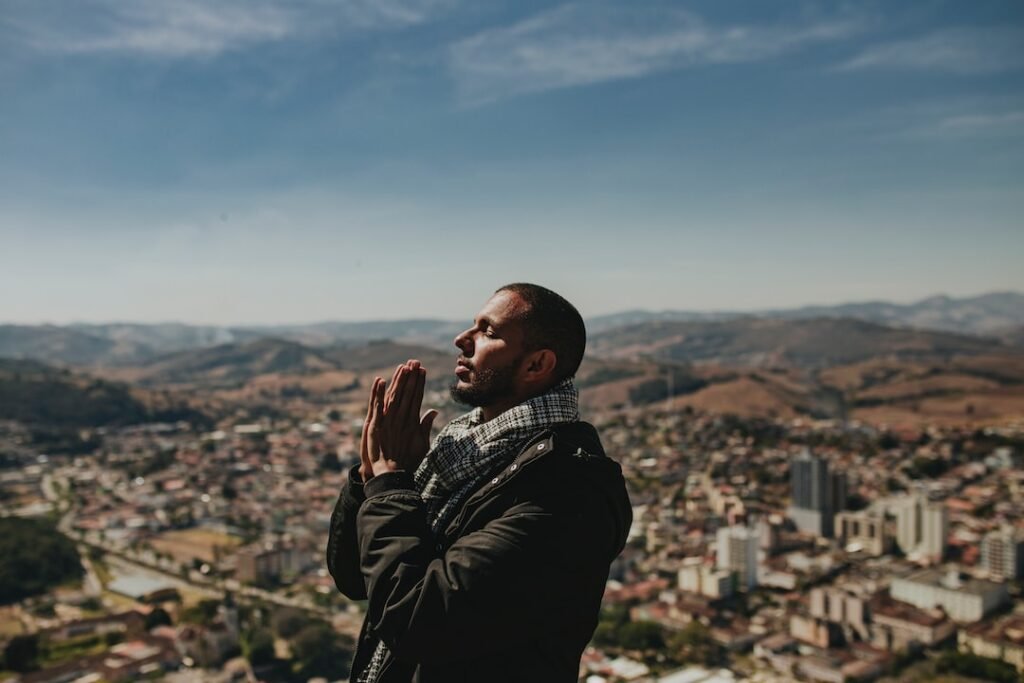
Table of Contents
Introduction
Faith and unbelief are two sides of the same coin that have been at odds with each other for centuries. As the world has become increasingly secular, the divide between these two worldviews has grown even wider. Understanding both faith and unbelief is essential for bridging the divide and having meaningful dialogue between the two camps.
This article is an exploration of atheism and secular perspectives in relation to faith. It looks at what atheism and secular perspectives mean, why people adopt them, and how they differ from faith. Additionally, it examines areas of commonality between faith and unbelief, how faith has been criticized, and how faith can be reconciled with disbelief.
It is important to note that atheism and secular perspectives are not the same. Atheism is the lack of belief in a god or gods, whereas secular perspectives are a broad set of beliefs that can include humanism, agnosticism, and skepticism. Atheism and secular perspectives both challenge the traditional understanding of faith, but they are not antithetical to faith.
The goal of this article is to provide an understanding of faith and unbelief so that we can build relationships rather than walls between them. We must comprehend why people adopt different positions in order to create a culture of understanding and respect.
In this article, we will start by exploring atheism and secular perspectives in greater depth. This will be followed by an exploration of the areas of commonality between faith and unbelief. We will then discuss faith’s critics and how faith can be reconciled with disbelief. We will end with a conclusion that encourages open dialogue between believers and non-believers.
In the end, this article will provide a better understanding of faith and unbelief, and how they can be reconciled in order to bridge the divide between them.

Understanding Atheism
Atheism is a fundamental lack of belief in any gods or deities. It is the opposite of theism, which is belief in an active deity. Atheism is not a new concept and has been around for centuries; however, it has become more prominent in recent years.
People become atheists for a variety of reasons. Some reject the concept of religion entirely and embrace the idea that there is no need for it in their lives. Others may have been raised in a certain faith and, upon further investigation, do not find the concept of God to be convincing. For some, it is simply an intellectual choice to reject religion because there is no scientific evidence to prove its existence.
There are many misconceptions about atheists. The most pervasive is that all atheists are immoral and destructive because they lack a belief in an all-powerful higher being, thus they have no morality or ethical code. This is far from true. Atheists are often just as moral and ethical as those who practice religion. They simply choose to rely on their own individual moral compass, rather than a faith-based one.
Another misconception is that atheists are incapable of spirituality. This is also untrue. Atheism does not necessarily equate to a lack of spirituality. Atheists can experience spiritual moments without believing in a higher power, such as when witnessing a beautiful natural phenomenon or when feeling connected with the world around them.
Finally, some wrongly assume that atheists have no faith at all. While atheists may not have faith in a higher power, they may have faith in humankind, nature, and other forces that cannot be seen or explained. As such, they may have strong beliefs in certain principles, such as justice and integrity, and strive to live their life according to these values.

Understanding Secular Perspectives
Secular perspectives represent an approach to life and a set of beliefs that are not necessarily connected to any religion or faith. The concept of secular perspectives isn’t new but has become increasingly important in recent years as more people look for ways to make sense of the world in a way that doesn’t require religious faith.
One fundamental aspect of secular perspectives is a commitment to the idea of reason as the primary way to understand and evaluate the world around us. This idea has been present in Western thought since the Enlightenment and has been championed by some of the world’s most influential philosophers. According to the secular point of view, reason is the primary tool for understanding the world, and faith should not be used as a substitute for reason.
People who adopt a secular perspective typically reject the idea that religious faith is a necessary part of life, and instead focus on living in harmony with reason, science, and personal experience. They generally view the world from a non-theistic perspective and don’t believe in a supernatural being that stands outside of the natural laws of the universe.
Many people who embrace a secular perspective are also committed to the idea of progress and the advancement of human rights. They believe that the values we hold dear, such as freedom of speech and equality for all, should be respected regardless of religion and that everyone has the right to make personal choices about their beliefs.
There are a number of misconceptions about the people who adhere to secular perspectives. One of the most common is that secular people are necessarily hostile to religion and faith. In reality, many secularists still consider themselves spiritual and may even consider themselves members of a particular faith tradition. They simply prioritize reason and critical thinking over religious dogma and spiritual tradition.
Another misconception is that all secular people are atheists. While many secularists do identify as atheist, it’s important to understand that atheism is not an absolute prerequisite for a secular perspective. Many secularists are agnostic or even theistic in their beliefs.
Embracing a secular perspective can be a challenging but rewarding journey. It’s important to remember that secular perspectives come from a deep respect for reason, science, and personal experience, and should not be used as an excuse to be hostile or dismissive of faith and religion.

Points of Commonality
Many people have the misconception that faith and unbelief are diametrically opposed, and that it is impossible for them to coexist. In reality, however, there are many points of commonality between faith and unbelief, and these areas of overlap can be used to bridge the divide between the two perspectives.
One area of shared values between faith and unbelief is the importance of relationships. No matter what a person’s views on the existence of a higher power, most people understand that the quality of our relationships with others is key to a meaningful life. Faithful and non-faithful alike can recognize this truth and strive to cultivate meaningful, healthy relationships.
Another shared value between faith and unbelief is the importance of morality and ethics. Whether a person believes in a higher power or not, they usually recognize the importance of living a moral life. This recognition is a cornerstone of a healthy society and can be a unifying force between faith and unbelief.
A third shared value between faith and unbelief is the notion of community. Even if a person does not have a faith tradition, they can still recognize the benefits of being part of a community. These communities can be based on shared interests or values, but the fact remains that a sense of community is beneficial to all, regardless of faith or disbelief.
Finally, there is the idea of spirituality. Whether a person is a believer or a non-believer, most recognize the importance of engaging in some form of spiritual practice. This could mean anything from meditation to prayer, but the idea is the same: engaging in some form of spiritual practice is beneficial to both faith and unbelief.
These are just a few examples of shared values between faith and unbelief. There are many more, but the point is that there is a great potential for understanding and acceptance between the two perspectives. By recognizing the commonalities between faith and unbelief, we can begin to bridge the divide and create a more cohesive society.

Faith and Critics
Faith has long been met with criticism and skepticism, and since the dawn of the Enlightenment, it has been challenged more and more. Although there have been periods of resurgence in religious participation, faith remains a contentious topic in many circles. From a philosophical perspective, faith has been critiqued in terms of epistemology, ethics, and metaphysics.
At its core, faith is about belief in the absence of direct evidence. It is a leap of faith in the unknown, and as such, it can be seen as opposed to the scientific method. It is a belief in something for which there is no empirical proof, and so this can be seen as antithetical to the concept of evidence-based reasoning.
From an ethical perspective, faith has been critiqued for its potential to limit individual autonomy, allow for the oppression of minorities, and even lead to intolerance of other belief systems. In particular, religious faith can be seen as a means of control and power, and this has been used to justify injustices throughout history.
From a metaphysical perspective, faith has been critiqued as being irrational and leading to superstition. It has been seen as an attempt to ascribe meaning to the unknown, and this has been seen as a form of wishful thinking. It can be argued that faith is a barrier to genuine understanding of the world, and that it is antithetical to the pursuit of truth.
In response to these critiques, many religious believers have argued that faith is not necessarily opposed to reason. It has been argued that faith can be seen as a complement to scientific inquiry, and that it can be seen as an essential tool for understanding the world. Faith can be seen as a means of connecting with the divine, and as such it can be seen as a valid source of knowledge.
Furthermore, it has been argued that faith can be seen as a means of ethical guidance. By connecting to a higher power, individuals can be encouraged to act with compassion and justice. Additionally, through faith, individuals may be better able to practice virtues such as patience and humility.
Finally, it has been argued that faith can be seen as a means of connecting to something deeper, and that it can lead to a greater understanding of the universe. By connecting to a higher power, individuals can gain a more holistic view of the world, and this can lead to a greater appreciation for the complexity and beauty of the universe.

Faith and the Unfaithful
For many who have grown up in a faith-based community, making a decision to abandon the faith of their upbringing can be a difficult and daunting task. For some, such a decision may be a result of a personal crisis of faith where the individual no longer believes in the tenets of their religion or no longer feels connected to the religion’s teachings. For others, it may be a logical choice made after a period of philosophical exploration and study. In either case, it can be a deeply personal and often confusing journey.
When it comes to faith and unbelief, there are various reasons why people choose to abandon their faith. A number of studies have found that the primary reason for leaving religion is a lack of belief in the specific teachings associated with a particular faith tradition. This could mean that an individual is no longer able to accept the notion of an all-knowing, all-powerful deity, for example. Other studies have highlighted that religious beliefs and practices can be seen as outdated and no longer relevant to contemporary society, leading many to abandon their faith in favor of more progressive, secular views.
Another common reason why individuals may choose to leave their faith is a desire to escape a particular community or group. For some, the pressure to conform to the expectations of a particular faith community can be overwhelming, leading to feelings of alienation or a need to break away. This may be especially true for those people who have experienced exclusion from their faith communities due to differences in sexual orientation or gender identity.
In addition to the difficulties associated with leaving one’s faith, there are also challenges involved in reconciling faith and unbelief. For many, it can be difficult to find a balance between the two, especially when the individual is no longer actively participating in their faith. It is not unusual for former believers to feel a sense of guilt or regret for leaving their faith, or to experience feelings of doubt or uncertainty when it comes to matters of spirituality and faith.
One way to bridge the divide between faith and unbelief is to look for points of commonality between the two. In many cases, there may be areas of overlap between faith and unbelief where the two can come together and find shared values. For example, many contexts of faith emphasize the importance of being kind, compassionate, and generous to others, values that can be embraced and celebrated by people regardless of their beliefs. Similarly, many secular perspectives emphasize the importance of justice, respect, and equality, values which can also be shared by believers.
It is also important to remember that not all former believers have completely abandoned their faith. There are many examples of former believers who remain engaged in spiritual practices in some capacity, such as meditation, prayer, or ritual. This demonstrates that, even in the absence of an active faith community, there can still be a meaningful connection to spiritual ideas and concepts.
Ultimately, it is important to remember that faith and unbelief are not necessarily opposing forces. By understanding and appreciating the different perspectives associated with faith and unbelief, we can better bridge the divide between the two and develop more meaningful connections between individuals and communities.

Conclusion
The divide between faith and unbelief can be a difficult one to bridge, but understanding and open dialogue are essential to navigating this divide. In this article, we have taken a closer look at atheism and secular perspectives, identifying their definitions, common misconceptions, and reasons for why people choose them. We have also identified areas of overlap between faith and unbelief, discussing shared values and offering ideas for how communities and individuals can bridge the divide. We have examined common critiques of faith, offering responses to better address these concerns, as well as looked at the reasons why people choose to abandon their faith and the challenges of reconciling faith and disbelief.
Through this exploration, we have seen that although faith and unbelief have their differences, they can co-exist, and through understanding and mutual respect, both sides can learn from each other. For those struggling to bridge the divide, it is important to remember that open dialogue is key. Listening to each other’s perspectives is essential in order to identify what we have in common and foster mutual respect.
The idea of a world united in faith and understanding is an ideal we can all strive for. As we create a more tolerant and understanding world, it is important to remember that faith and unbelief are not mutually exclusive. By having open dialogue and learning from each other’s perspectives, we can create a world where faith and unbelief can peacefully co-exist.
At the end of the day, understanding faith and unbelief is essential to finding common ground. As we look to bridge the divide, it is important to remain open-minded and to approach conversations with an attitude of respect and curiosity. It is only through open dialogue and mutual understanding that we can begin to better understand faith and unbelief and foster a more tolerant and inclusive world.
Join the Realty Banker Network and stay ahead of the competition. Connect with us on
Youtube, Facebook, TikTok, Instagram and Twitter. We hope to see you there.

